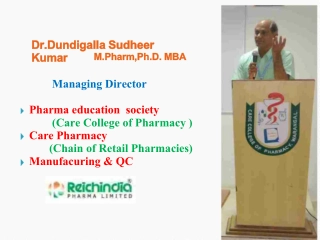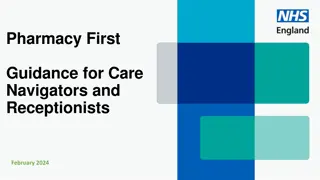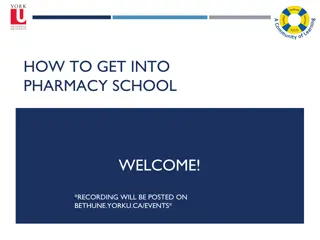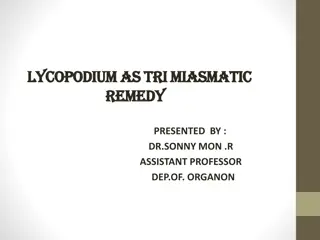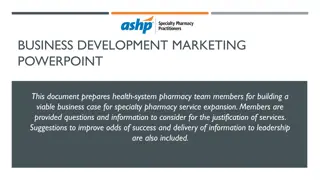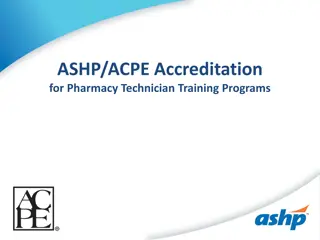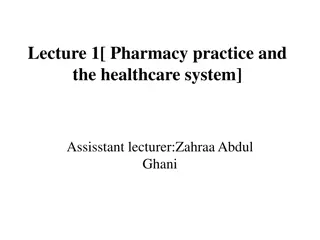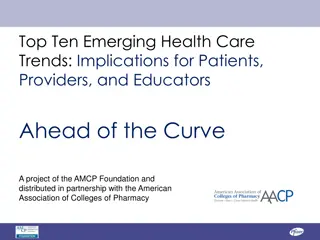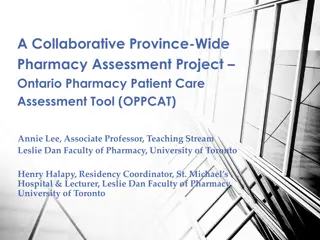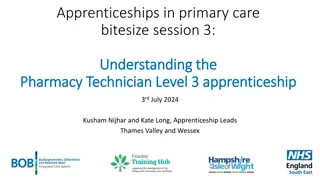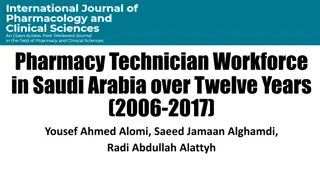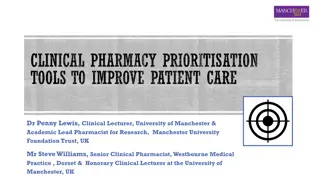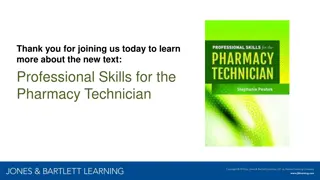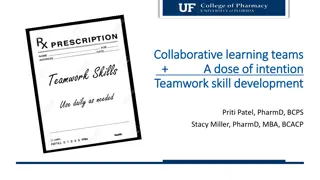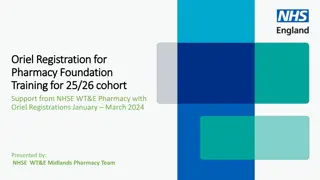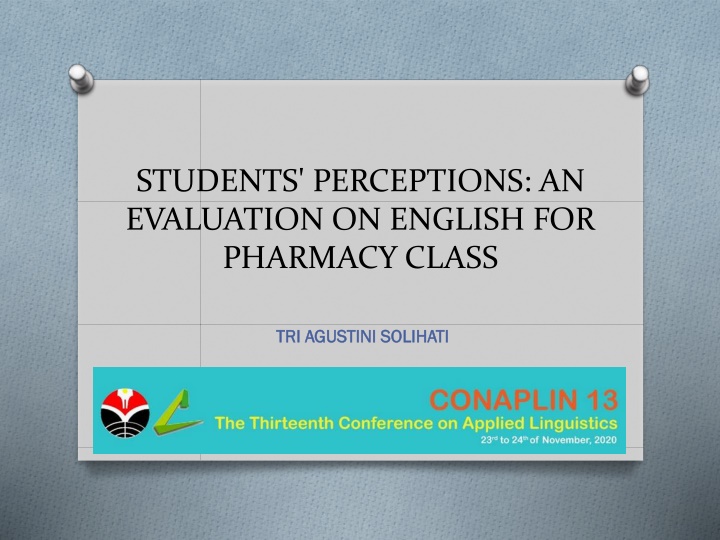
Evaluation on English for Pharmacy Students: Perceptions & Findings
Recent global trends highlight the increasing need for English proficiency among professional pharmacists. This evaluation explores students' perceptions of English within the pharmacy class, emphasizing the importance of adapting pharmaceutical science instruction to current societal conditions. The study aims to assess learning objectives, course materials, and teaching processes to enhance English learning experiences for pharmacy students.
Download Presentation

Please find below an Image/Link to download the presentation.
The content on the website is provided AS IS for your information and personal use only. It may not be sold, licensed, or shared on other websites without obtaining consent from the author. If you encounter any issues during the download, it is possible that the publisher has removed the file from their server.
You are allowed to download the files provided on this website for personal or commercial use, subject to the condition that they are used lawfully. All files are the property of their respective owners.
The content on the website is provided AS IS for your information and personal use only. It may not be sold, licensed, or shared on other websites without obtaining consent from the author.
E N D
Presentation Transcript
STUDENTS' PERCEPTIONS: AN EVALUATION ON ENGLISH FOR PHARMACY CLASS TRI AGUSTINI SOLIHATI TRI AGUSTINI SOLIHATI
Outline O Introduction O Review of the literature O Research Methodology O Findings and discussion O Conclusion and recommendation O References
Introduction Burning Burning Issue Issue O Recent global trends confirm the increasing needs of English mastery for professional pharmacists (Filice and Turino, 2002). English mastery is badly needed to cope with the global change of the healthcare system. In this case, pharmaceutical science instruction should always be adjusted with the recent condition in society. As with the global Covid-19 pandemic, pharmacists belong to the front line to fight against the virus, and they are doing their best to support the patients despite their backgrounds and origins. Lack of English mastery will seriously affect their ability to provide service to their patients. Given the situation above, an area of specialized English learning should be well-arranged for pharmacy students. Purpose of the Purpose of the Study Study O The aim of this study is to establish students' perception of English for pharmacy class covering learning objectives, course materials, and teaching and learning process.
Introduction Theoretical perspective (very related theories perspective (very related theories) and Previous Related Research Reports Related Research Reports English for Specific Purposes is related to the raises of certain activities, movements, and subjects done in English in the whole world, which is considered from working or career demands (Steven 1977) as cited in (Harrabi, 2018: 20). And in the last learning activity, evaluation and assessment on the syllabus are carried out. It measures the entire performance on the success of reaching the goals (Okeke & Ada, 2014: 186). A Program Evaluation of an English Course for Turkish Erasmus Exchange Students, written by Fatma Yuvayapan in 2015. O Theoretical ) and Previous
Introduction O Thesis Statement Thesis Statement English for Specific Purpose (ESP) is referred to teaching and learning English as a second language or a foreign language that is used in the academic, professional, or certain workplace (Galina, 2016: 529). Course evaluation is a tool that provides a general picture of what a course was or is like, it reveals important information that could improve the course in the future, and proves if it was successful in meeting its goal or not (Salazar, et al. 2015). Thus to get comprehensive appropriateness between the expectations for better improvement, an evaluation should be carried out. information course on students' the and
Introduction O Statement Statement of the The researcher decided to find out by studying opinion of the students about learning objectives, course material, and learning process in the future. O Research Research Question Question What are students' perceptions of English for pharmacy class? O The Scope of the The Scope of the Study Study this research is focused on students' perception toward the learning objectives, course content, and learning process in English for pharmacy class. O Significance of the Significance of the Study Study 1. Getting comprehensive information about English for pharmacy class, which covered learning objectives, course content, and the learning process. 2. Providing a general picture of the course to design a better improvement later on. of the Problem Problem
Introduction O Definition Definition of of Terms 1. 1. Learning Learning objective to owned and mastered by students. 2. 2. Course Course content/material content/material; a material got by the students to improve their ability and to meet the determined basic competency. 3. 3. Learning Learning process process; It provides learners with the opportunity to engage with specific ideas and concepts on a need-to-know or want-to-know basis. Terms objective; an expected learning result
Review of the Literature O English for Specific English for Specific Purpose 1. Dudley Evans (1998) as cited in (Donesch, 2012: 2) stated that English for Specific Purposes (ESP) is defined to fulfill the specific needs of students. 2. ESP for adults commonly has Basic English skill and they are learning to communicate in relation to professional and career demands (Hutauruk, 2012). 3. The characteristic of ESP is to fulfill specific learning needs (Javid, Choudhary Zahid, 2013: 140). O Course Evaluation Course Evaluation Evaluation is an essential stage in every ESP course. This is inseparable to the course design, including need analysis, syllabus design, course content, teaching methodology, learning activities and implementation, and assessment ((Momeni & Rasekh, 2012) as cited in (Celik & Ece, 2016: 327). Purpose
Research Methodology O Check & Schutt (2012), as cited in (Ponto, et al. 2015: 168), stated that a survey is collecting information from individual sampling through the response on questions. O Kerlinger (1973), as cited in (Mathiyazhagan & Deoki, 2010: 39) classified data collection method into a personal personal interview, interview, questionnaire, observation. O There are 23 adopted items in the questionnaire (Fatma, 2015). The first five are about learning objectives. The next 12 items are about the course content. And the rest is about the learning process. O The questionnaire was sent to 160 respondents. O The questions were in the form of close-ended questions by choosing the provided statements (strongly agree, agree, disagree, and strongly disagree). O The total number of choices will be divided by the number of total participants, then times to 100%. questionnaire, a a phone phone call call, and
FINDINGS AND DISCUSSION O Learning objectives Learning Objectives 80 70 60 50 40 30 20 10 0 Number 1 Number 2 Number 3 Number 4 Number 5 Strogly agree Agree Disagree
FINDINGS AND DISCUSSION O Course content Course content/materials 90 80 70 60 50 40 30 20 10 0 Number 1 Number 2 Number 3 Number 4 Number 5 Number 6 Number 7 Number 8 Number 9 Number Number 11 Number 12 10 Strongly Agree Agree Disagree
FINDINGS AND DISCUSSION O Teaching and Learning process Teaching and Learning Process 80 70 60 50 40 30 20 10 0 Number 1 Number 2 Number 3 Number 4 Number 5 Number 6 Number 7 Strongly Agree Agree Disagree
CONCLUSION (1) learning objectives determined by the lecturer, which is in line with the vision and mission of the institution had already been reached successfully. It met students' expectations of English courses as well as their language skills, including listening, speaking, reading, and writing. (2) Course materials/content enrich students' knowledge, improve their vocabulary mastery, develop their language skills, provide an authentic situation in the learning process, engage students in classroom activity, provide students to learn independently, have the appropriateness on course materials, have the appropriate material structure, have a variety of course materials, have informative course materials, give a better influence on learning, and identify the strengths and weaknesses of students. (3) The teaching and learning English process was effective and efficient, easy to follow, had good student-teacher interactions, built cooperative relationships, had an interesting teaching process, had an effective methodology, and encouraged active participation.
RECOMMENDATION (1)Give additional time for those who have no adequate basic English skill. (2)Try to have the smaller quantity for each class, ranging from 20-25 students. (3)Vary teaching method to keep students motivation in studying English.
REFERENCES (2009). Report on a http://www.amc.org Acosta Salazar, Ana Yeraldin, dkk. (2015). Evaluating an English for Specific Purposes Course for Law Students. No. 23: 263-283. ISSN 1659-1933. Basturkmen & Ana. (2018). Materials Design Processes, Beliefs and Practices of Experiented ESP Teachersin University Settings in Spain. Springer: Doi https://doi.org/10.1007/978-3-319-70214- 8-2. Basturkmen, Helen. (2010). Developing Courses in English for Specific Purposes. New Zealand: Palgrave Macmillan Celik & Ece. (2016). Evaluation of the Methodology of an ESP Reading Skills Course for Undergraduate Medical Students: Outsider Perspective. International Conference on Teaching and Learning English as an Additional Doi:10.1016/j.sbspro.2016.10.030. Donesch, Ewa. (2012). English for Specific Purposes: What does it mean and why is it different from teaching General Teaching? Confleunce.: 1-7. ISSN 2250-138X. Eddine, Chams. 2016. An Introduction to English for Specific Purpose (ESP). Algeria: Aboe Bekr Belkaid University. Fatma, Yuvayapan. (2015). A Program Evaluation of an English Course for Turkish Erasmus Exchange Students. International Journal of Language Academy. Vol. 3, No. 1: 39-56. Galina. (2016). The Essence of English for Specific Purposes. International Scientific Conference "Perspective and Problems of Integration in the European Research and Education Area" State University B.P. Hasdeu from Cahul. Vol. 2: 528-531. AAMC-HHML. basic science competencies. Retrieved from O O O O O Language, GlobELT: 326-331. O O O O

